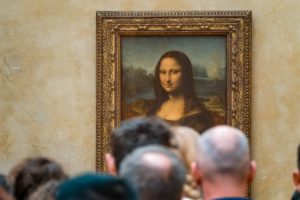Bearings at the Louvre?

The “Mona Lisa”
Do you know what connects the Pyramids, the “Mona Lisa”, and a healthy smile? Pssst, it’s bearings.
Leonardo da Vinci, the artist, cartographer, astronomer, and painter of “The Last Supper” and the “Mona Lisa”, was also an engineer. His research and discoveries predated the invention of helicopters, tanks, submarines, watch works, and even parachutes by centuries. It was in his design for an early helicopter, in 1500 (!) where da Vinci first diagrammed a bearing.

Egyptian pyramid and workers
da Vinci wasn’t the first to use bearings. There’s evidence to show both ancient Egyptians and ancient Romans used bearings of one kind or another. The Egyptians used plain bearings to transport huge blocks of stone to build the pyramids. Drawings show workers riding on large sleds with runners and pouring water on the sand to decrease friction. The Romans used rolling ball bearings later. Researchers found a rotating table on a wooden ball bearing in Roman ruins dated 40 BC. We still use wooden ones in grist mills and water wheels. I’m getting to the healthy smile part.

Water wheel
Another famous Renaissance man, Galileo Galilei, conceptualized the caged bearing. In the 1700s, watchmakers began using caged roller bearings in their designs. These days, fine watches use sapphire bearings to lessen friction, creating a more precise timepiece. Still not smiling?

Dentists work on a patient
Today, manufacturers, engineers, and fabricators need ball bearings to keep their machines moving. They’re in so many different types of products, we often take them for granted, but without bearings, dental drills, milling machines, and robotic arms would come to a halt. Well, maybe we wouldn’t mind the dental drills stopping.
What connects the Pyramids, the “Mona Lisa”, and a healthy smile? You guessed it.
In other words, without Leonardo da Vinci, we’d all have toothaches.
Photo credits: Museum photo by Free Birds on Unsplash | Pyramid photo by Les Anderson on Unsplash | “Water Wheel” by Walt Stoneburner is licensed under CC BY 2.0 | Photo by Bofu Shaw on Unsplash